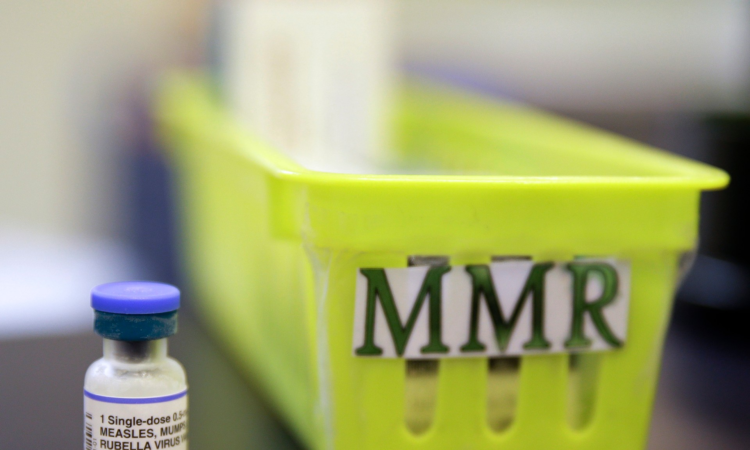
As Northern Ireland reports its first case of the disease in seven years, the rest of the UK has seen a surge over the past year.
On Tuesday, the first case of measles in seven years was reported in Northern Ireland.
Outbreaks of measles have sprung up in parts of Britain in recent months amid concerns of what Dr Vanessa Saliba from the UK Health Security Agency (UKHSA), has called a “worryingly low MMR [measles, mumps and rubella] vaccine uptake in some areas across the country”.
So where and why is measles on the rise in the UK?
In the four weeks since January 22, 169 new cases of measles have been recorded in England, taking the total number of confirmed cases there since the start of October to 581.
To put that into perspective, there were only two confirmed cases of measles across the whole of the UK in 2021 and 54 one year later.
This month, a man in his 40s died in Ireland after contracting the virus during a visit to the West Midlands in England, where UK measles cases are among the most prevalent and at their highest since the 1990s. That case has focused the minds of many health professionals in the British Isles.
This week’s case reported in Northern Ireland was found in an adult who also became infected while travelling. Measles, which was recorded as long ago as the ninth century by Persian doctor Rhazes, can be serious for both adults and children.
If coughs and sneezes spread diseases, then measles is one such illness to which that old adage applies.
Common symptoms of measles, which is caused by a virus, include a high fever, sore and watery eyes, coughing and sneezing. These symptoms are accompanied by a red rash all over the body. While measles can be contracted at any age, children are most at risk.
Most people who catch measles recover within seven to 10 days, but in more serious cases, it can cause pneumonia, meningitis, seizures, complications leading to blindness and even death.
In more affluent parts of the world, measles is fatal in about one in 5,000 cases. But in poorer regions with less robust healthcare systems, as many as one in 100 who catch measles will die from it. Over the past decade, deadly measles outbreaks have been documented in the Democratic Republic of the Congo, Samoa and Pakistan among other countries.
Prior to the introduction of the first measles vaccine in 1963, 2.6 million people died from the disease worldwide each year. In 2016, despite a much higher overall global population, 90,000 people died from measles. In 2017, the World Health Organization declared that the UK had eliminated measles as a result of vaccine use.
Roald Dahl, the Welsh-born children’s author, lost his daughter Olivia to the virus in 1962 at the age of seven after she developed measles encephalitis.
While the measles vaccine came one year too late to protect Olivia Dahl, an improved version that caused fewer side effects was developed in 1968 by which time inoculations had been rolled out across parts of Africa.
The MMR vaccine, first introduced in Britain in 1988 and still used today, offers lifelong protection against measles, mumps and rubella and is 99 percent effective. As part of the UK national vaccination programme, it is normally given to children in two doses: at 12 months and again at around three years and four months.
A triple-shot MMR vaccination is now used across many parts of the world. It has proved highly effective in reducing infections.
According to the World Health Organization, “between 2000 and 2020, measles vaccination prevented an estimated 31.7 million deaths worldwide.”
In England, the most populous of the UK’s four constituent nations, uptake of the MMR vaccine in children for 2022-2023 was recorded at about 85 per cent, the lowest level since 2010-2011, sparking fears that this highly contagious but preventable disease could make a comeback in Britain.
Despite saving millions of lives globally, the MMR vaccine has proved fertile ground for conspiracy theorists.
The British physician Andrew Wakefield made headlines in 1998 when a study he wrote was published in the international medical journal The Lancet. His study linked the MMR vaccine to the development of autism in children despite his findings being based on only 12 patients.
Wakefield was later unveiled as a fraud. He was found to have had a financial interest in claiming a damaging link to the MMR vaccine, and his conclusions were debunked. But the damage was done.
The average uptake of MMR in England dropped sharply from 91.8 percent in 1996 to 79.9 percent in 2004, and cases of measles rose, largely as a result of his false claims.
Experts said today’s drop in MMR uptake in Britain – the National Health Service England said 3.4 million children under 16 have not been inoculated – is down to a number of factors.
They include a conflation of anti-vax conspiracy theories during the pandemic when myths peddled about the COVID-19 vaccine rubbed off on the MMR vaccine, causing scepticism in some parents. In 2019, the European Commission and the World Health Organization urged governments to take action against the spread of misinformation about vaccines.
Cases of tuberculosis (TB), an illness caused by a bacterial infection that many in Britain today associate with the Victorian and Edwardian eras, rose by 11 per cent last year in England.
There were, according to the UKHSA, 4,850 cases of TB in England in 2023 as opposed to 4,380 in 2022.
TB, known as “consumption” in the 1800s because sufferers often lost weight and almost wasted away, commonly affects the lungs, and symptoms include a persistent cough, a high temperature and loss of appetite.
As was the case in the past, TB remains linked to poverty and deprivation, but can be successfully treated today with antibiotics. However, if left untreated, TB can still prove fatal.
Follow Al Jazeera English:







